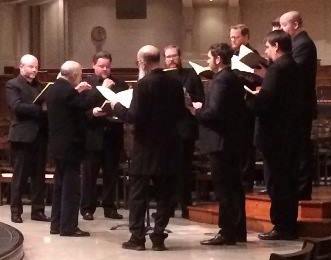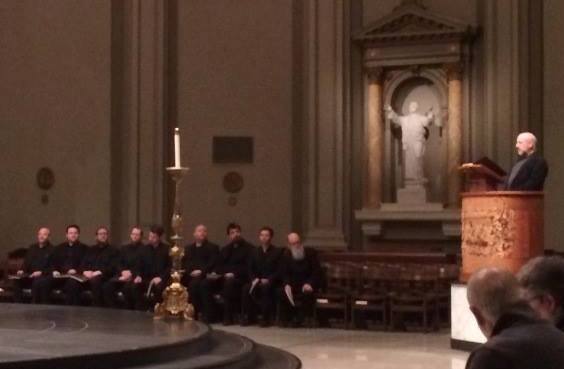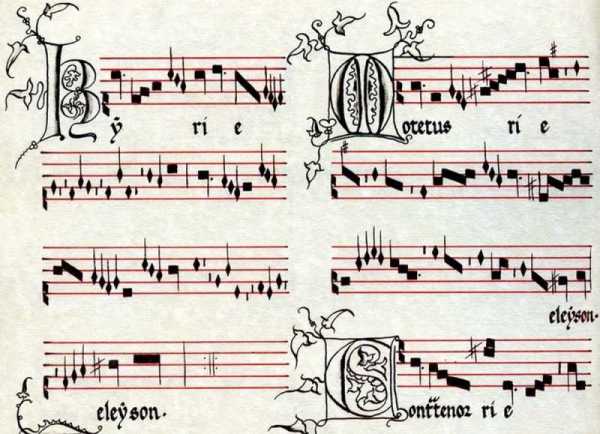
Guillaume de Machaut: Messe de Nostre Dame
Performed February 2, 2018 by
Marcel Pérès and
Cappella Romana
St. James
Cathedral, Seattle
Machaut's mass in context
When the Portland-based early music group Cappella Romana announced they would be touring the Pacific Northwest with Marcel Pérès and a program centered on Guillaume de Machaut's Messe de Nostre Dame, I wondered if the performances would feature the gruff, Corsican-influenced vocal style and unorthodox ornaments with which Pérès is closely associated. To find out, I attended the February 2, 2018 tour opener at St. James Cathedral in Seattle, looking forward to another opportunity to hear the work most frequently cited as the pinnacle of Medieval polyphony.
The evening did track very closely with the 1995 recording of the
Messe by Pérès and the France-based
Ensemble Organum
which he co-founded 13 years previously (video above).
There was the brash, guttural singing style, the
microtonal ornaments (usually quasi-trill/ululation), and the broad tempos
in the polyphonic mass movements calculated to allow said ornaments to be heard in a
highly reverberant space. The ensemble consisted of nine male vocalists (thus
doubling Machaut's four polyphonic lines) with no women and no instruments
(not even annunciatory bells). The Latin pronunciation was French-inflected (Jesu
came out "Yehzü"
not "Yehzoo",
and Dona nobis pacem got "paasem" not the Italianate "paachem").
And each of the
three sections of the Kyrie was repeated thrice (making nine reps in all,
following the liturgical standard of the time), with the triplum
(usually the highest of the lines) dropped during the middle reps, leaving a
three-voice texture that emphasized the motetus voice.

Pérès (2nd from L) conducting Cappella Romana
Also as in the recording, the program consisted of a reenactment of the musical portions of a mass as Pérès imagines it might have sounded at Rheims in the late 14th century. Pérès even reused the Proper texts and chants from the recording, those associated with the mass for the Purification of the Virgin Mary, which in a happy coincidence is assigned in the 2018 ecclesiastical calendar to the exact date of the concert. Accordingly, the evening began with a monophonic introit, and the polyphonic mass movements composed by Machaut for the Ordinary were heard in their designated places in the proceedings. Pérès conducted throughout, and handled the solo chanting of the epistle and gospel readings himself, with Cappella Romana joining in on the plainchant sections historically sung by the Schola. Of course this wasn't a real mass: there was no Priest, no Host, and no non-musical goings-on (though Pérès did ascend St. James' modest pulpit for the readings).
Boring and interesting Gregorian chant
Pérès, of course, is something of a maverick within the early music community. In addition to the unusual vocal sound he cultivates, he also feels that traditional methods of singing plainchant (and of pronouncing church Latin) persisted in Western Europe much longer than many other scholars accept, in some cases well into the 19th century. A contrasting view is represented by someone like R. John Blackley, who argued that that once notation became established in the Western Church (and diastematic notation of plainchant had indeed been in use in France for a few centuries by the time the Messe was written), monks began to learn the tunes from the written form, instead of by rote, and thus the nuances and details that had previously characterized the art form (but which weren't captured by the crude notation of the time) were gradually lost in favor of a simpler style closer to the dull equalist chant that's ubiquitous in modern recordings (and which was codified as "official" by the Church following the revival of Gregorian chant spearheaded by the monks of Solesmes in the late 19th century).
However scholars might come down on the matter, it's unassailable that although we can't know for sure how Gregorian chant sounded before it was first written down (say, before the year 800), it must have been closer to Pérès' vision than to the all-equal-notes stereotype that has become ensconced today. My opinion is that it probably sounded very similar to certain "neighboring" traditions that are still intact, such as the call to prayer that you might hear sung by a minimally-acculturated mu'adhin standing in a minaret in the Arabian peninsula. Pérès himself has spent a lot of time exploring Corsican chant as a model, and Blackley's own recording Tenth-century Liturgical Chant In Proportional Rhythm offers a different speculative reconstruction of the "original" sound of this music.
Pérès delivers the epistle while Cappella Romana watches
The quintessence of Medieval polyphony
Returning to Machaut, one side benefit of Pérès' slow tempos is the clarity it affords certain musical details in this most thoroughly analyzed of all Medieval compositions. One of its most immediately striking features is the contrast between the Gloria and Credo movements, whose lengthy texts are given a syllabic, homophonic treatment similar to that in contemporaneous conductus settings, and the other movements (and the closing Amen section of the Gloria), which receive a more florid polyphonic treatment typical of Ars Nova motets. The idea of setting the Gloria and Credo in a distinct homophonic fashion was so advanced that it took 200 years for it to be revived, in the masses of Palestrina.
As for the motet-style movements, they are built around an isorhythmic tenor (usually the second-lowest voice in the texture) whose notes are derived from a preexisting plainchant melody (or cantus firmus). Often the contratenor (the lowest voice) is also isorhythmic, meaning that it uses repeating taleas (rhythmic cycles), though unlike the tenor it does not quote plainchant.
Here is the cantus firmus for the first Kyrie (5:17 in the linked video). The pitches come from a famous plainchant Kyrie, and the note values follow a talea that lasts four bars when transcribed into modern notation. If you follow along in the full score, note how measures 20–24 are a rhythmic repetition of measures 8–12 in each of the four voices.
Another characteristic Machaut effect is described by Richard Taruskin as "wild activity regularly hitting the brick wall of utter stasis". It can be heard throughout the Christie eleyson section, and it anticipates the "drive to the cadence" effect that was a common trait in Renaissance masses and 16th century grounds.
The overall range of Machaut's texture is two octaves. Cadences are consistently of the double leading tone type that so reliably identifies Medieval polyphony (this kind of cadence disappears in Renaissance music). Aside from final cadences, which always close on open fifths, most of the chords (or "vertical occurrences" if you prefer) are triads, usually in root position, sometimes in first inversion. One interesting detail is that the the first three movements are in what we nowadays call D Dorian, whereas the final of the last three movements is F, usually with a downward inflected 4th scale degree approximating the modern major scale. This primordial relative major relationship is elsewhere exploited by Machaut within a single piece.
In his approach to Machaut's masterpiece, the earliest surviving mass attributable to a single composer, Pérès seems mainly focused on interpretive questions, especially the use of ornamentation as a means of underscoring the energy of the music and the resonances of the text. He seems less interested in the ongoing scholarly sleuthing that the Messe attracts, such as Anne Walters Robertson's recent claim that the Gloria paraphrases a plainchant melody then in use at Rheims (her argument has convinced several other scholars, including Taruskin, though from a strictly musical perspective I'm skeptical of the intentionality of the quotation—if legitimate, though, it would anticipate the later practice of paraphrase mass by a solid century). Pérès, whose English is much better than my French, kindly showed me the modern manuscript of the Messe that he uses in performance. It was handwritten by one of his late Ensemble Organum colleagues, and is basically a cleaned-up and lightly annotated recreation of the original 14th century manuscript, using choirbook layout, Franconian notation and five-line staves, but no tempus/prolatio mensural signs (the forerunners of modern time signatures) which were not yet in universal use in France. Here is an excerpt from the second Kyrie. Among other things, you can see how space-efficient this notation is (parchment was expensive!), and how the choirbook format, where each part is given in succession, imposes a contrapuntal prejudice on one's outlook:
Ancient to the Future
The most visceral part of the recital was simply the experience of hearing this music in a close approximation to its original acoustical and architectural context. What's more, partaking in Machaut's Messe reinforces why Medieval music is so fascinating to contemporary composers. Listening to it is rather like listening to a 20th century landmark composition for the first time. The music is speculative, exploratory, even avant-garde. You can tell that its practitioners were eager to learn how polyphony worked: how voices should move, how textures might be built, which intervals should be considered consonant or dissonant, and how one could possibly capture these newfangled ideas in written form—the very concept of a "piece" of music as a physical manifestation on a scrap of parchment. When you hear these sounds, you're listening to the birthing of Western art music, the fledgling of a new musical language—even if that sense of striving is less evident in the Messe (which culminated both Machaut's career and a particular lineage of French polyphony reaching back three centuries) than it might be in Machaut's more experimental chansons, or the motets and organa of his Frankish predecessors.
In contrast to the Renaissance music that succeeded it—polished, accomplished and confident in its mastery of new technique—Medieval music conveys the edginess of exploration and discovery, even of upheaval and danger. Machaut managed to survive into his 70s surrounded by the Black Death, the Hundred Year's War and the exile of the Papacy to Avignon. And his century, as calamitous as it was innovative, is often compared to our own time. It's fitting that his valedictory work, the product of such tumult and persistence, should convey so directly to modern listeners a momentous range of musical and human experience.
- February 2018
![]()
Selected writings |
Schellsburg home
Jerry Hunt |
cribbage
![]()
Original Material and HTML Coding Copyright © 2018 by
Michael Schell. All Rights Reserved.



